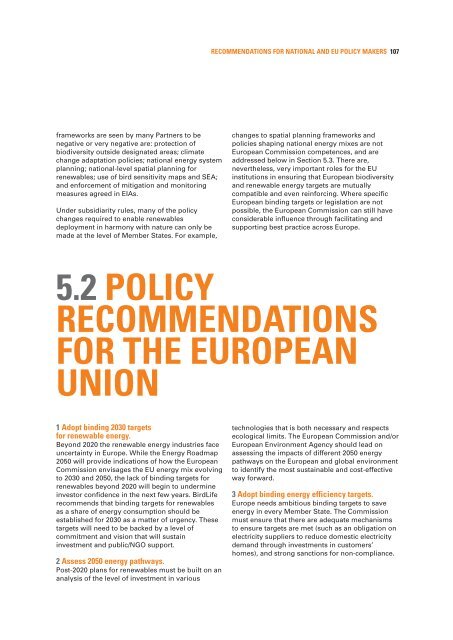Meeting Europe's renewable energy targets in harmony with - RSPB
Meeting Europe's renewable energy targets in harmony with - RSPB
Meeting Europe's renewable energy targets in harmony with - RSPB
Create successful ePaper yourself
Turn your PDF publications into a flip-book with our unique Google optimized e-Paper software.
RECOMMENDATIONS FOR NATIONAL AND EU POLICY MAKERS 107<br />
frameworks are seen by many Partners to be<br />
negative or very negative are: protection of<br />
biodiversity outside designated areas; climate<br />
change adaptation policies; national <strong>energy</strong> system<br />
plann<strong>in</strong>g; national-level spatial plann<strong>in</strong>g for<br />
<strong>renewable</strong>s; use of bird sensitivity maps and SEA;<br />
and enforcement of mitigation and monitor<strong>in</strong>g<br />
measures agreed <strong>in</strong> EIAs.<br />
Under subsidiarity rules, many of the policy<br />
changes required to enable <strong>renewable</strong>s<br />
deployment <strong>in</strong> <strong>harmony</strong> <strong>with</strong> nature can only be<br />
made at the level of Member States. For example,<br />
changes to spatial plann<strong>in</strong>g frameworks and<br />
policies shap<strong>in</strong>g national <strong>energy</strong> mixes are not<br />
European Commission competences, and are<br />
addressed below <strong>in</strong> Section 5.3. There are,<br />
nevertheless, very important roles for the EU<br />
<strong>in</strong>stitutions <strong>in</strong> ensur<strong>in</strong>g that European biodiversity<br />
and <strong>renewable</strong> <strong>energy</strong> <strong>targets</strong> are mutually<br />
compatible and even re<strong>in</strong>forc<strong>in</strong>g. Where specific<br />
European b<strong>in</strong>d<strong>in</strong>g <strong>targets</strong> or legislation are not<br />
possible, the European Commission can still have<br />
considerable <strong>in</strong>fluence through facilitat<strong>in</strong>g and<br />
support<strong>in</strong>g best practice across Europe.<br />
5.2 POLICY<br />
RECOMMENDATIONS<br />
FOR THE EUROPEAN<br />
UNION<br />
1 Adopt b<strong>in</strong>d<strong>in</strong>g 2030 <strong>targets</strong><br />
for <strong>renewable</strong> <strong>energy</strong>.<br />
Beyond 2020 the <strong>renewable</strong> <strong>energy</strong> <strong>in</strong>dustries face<br />
uncerta<strong>in</strong>ty <strong>in</strong> Europe. While the Energy Roadmap<br />
2050 will provide <strong>in</strong>dications of how the European<br />
Commission envisages the EU <strong>energy</strong> mix evolv<strong>in</strong>g<br />
to 2030 and 2050, the lack of b<strong>in</strong>d<strong>in</strong>g <strong>targets</strong> for<br />
<strong>renewable</strong>s beyond 2020 will beg<strong>in</strong> to underm<strong>in</strong>e<br />
<strong>in</strong>vestor confidence <strong>in</strong> the next few years. BirdLife<br />
recommends that b<strong>in</strong>d<strong>in</strong>g <strong>targets</strong> for <strong>renewable</strong>s<br />
as a share of <strong>energy</strong> consumption should be<br />
established for 2030 as a matter of urgency. These<br />
<strong>targets</strong> will need to be backed by a level of<br />
commitment and vision that will susta<strong>in</strong><br />
<strong>in</strong>vestment and public/NGO support.<br />
2 Assess 2050 <strong>energy</strong> pathways.<br />
Post-2020 plans for <strong>renewable</strong>s must be built on an<br />
analysis of the level of <strong>in</strong>vestment <strong>in</strong> various<br />
technologies that is both necessary and respects<br />
ecological limits. The European Commission and/or<br />
European Environment Agency should lead on<br />
assess<strong>in</strong>g the impacts of different 2050 <strong>energy</strong><br />
pathways on the European and global environment<br />
to identify the most susta<strong>in</strong>able and cost-effective<br />
way forward.<br />
3 Adopt b<strong>in</strong>d<strong>in</strong>g <strong>energy</strong> efficiency <strong>targets</strong>.<br />
Europe needs ambitious b<strong>in</strong>d<strong>in</strong>g <strong>targets</strong> to save<br />
<strong>energy</strong> <strong>in</strong> every Member State. The Commission<br />
must ensure that there are adequate mechanisms<br />
to ensure <strong>targets</strong> are met (such as an obligation on<br />
electricity suppliers to reduce domestic electricity<br />
demand through <strong>in</strong>vestments <strong>in</strong> customers’<br />
homes), and strong sanctions for non-compliance.
















